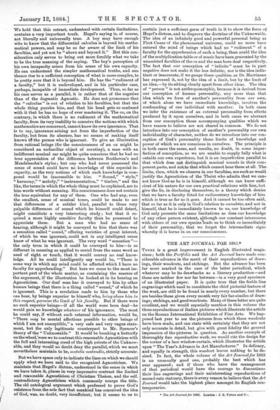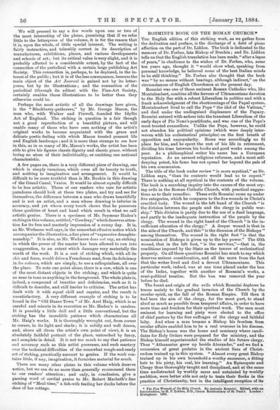THE ART JOURNAL FQR 1883.*
THEB.E is a great improvement in English illustrated maga- zines ; both the Portfolio and the Art Journal have made con- siderable advance in the merit of their reproductions of draw- ings, their woodcuts, and etchings. But the advance has been far more marked in the case of the latter periodical, which whatever may be its drawbacks as a literary production—and these are neither few nor far between—is a very good specimen of an illustrated paper. It is quite true that the feeble line engravings which used to constitute the chief pictorial feature of the work, are still to be found in nearly every number, but there are besides these given every month very fair fac-similes of draw- ings; etchings, and good woodcuts. Many of these latter are quite excellent, and we would especially mention in this volume the three reproductions of Italian pictures which illustrate the article on the Roman International Exhibition of Fine Arts. We hap- pened last year to see the pictures from which these woodcuts have been made, and can state with certainty that they are not only accurate in detail, but give with great fidelity the general impression of the pictures in question. As another example of thoroughly fine reproductive work, we would cite the design for the corner of a lace window-curtain, which illustrates the article upon " The Year's Advance in Art Manufactures." In delicacy, and equally in strength, this woodcut leaves nothing to be de- sired. In fact, the whole volume of the Art Journal for 1883 is an unusually good one, probably the best which has ever appeared ; and if those who have the management of that periodical would have the courage to discontinue their line engravings and their uninteresting reproductions of second-rate statuary, there is every reason to believe that the Art Journal would take the highest place amongst its English con- temporaries.
* The Art Journal for 1883. Loudon : J. O. Virtue and
We will proceed to say a few words upon one or two of the most interesting of the plates, premising that if we refer little to the letterpress of the volume, it is for the reason that it is, upon the whole, of little special interest. The writing is fairly instructive, and tolerably correct in its description of manufactures, exhibitions, places, and various developments and schools of art ; but its critical valve is very slight, and it is probably affected to a considerable extent, by the fact of the connection of the periodical with a certain large publishing Art Society. This connection is, perhaps, to be deplored, in the in- terest of the public ; but it is of the less consequence, because the main object of the Art Journal is gained not by its letter- press, but by its illustrations ; and the connection of the periodical (through its editor) with the Fine-Art Society, certainly enables those illustrations to be better than they -otherwise could be.
Perhaps the most artistic of all the drawings here given, is the " Blackberry-gatherers," by Mr. George Mason, the man who, with Walker and Pinwell, founded the Idyllic Art of England. The etching in question is a fair though not a good reproduction of a beautiful picture, and will -enable many of those who have seen nothing of the artist's original works to become acquainted with the grace and delicate poetic feeling with which Mason treated peasant life and English landscape ; and it is more than strange to see how in this, as in so many of Mr. Mason's works, the artist has been able to give his figures classic dignity and classic grace, without losing an atom of their individuality, or omitting one national -characteristic.
A few pages on, there is a very different piece of drawing, one which is simply veracious, which owes all its beauty to truth,
and nothing to imagination and arrangement. It would be difficult to be more truthful than is Mr. Ruskin in this drawing of the Grand Canal, Venice. It would be almost equally difficult to be less artistic. Those of our readers who care for artistic
paradoxes should look at these two plates, and try and see for -themselves, the difference between a man who draws beautifully
and is not an artist, and a man whose drawing is inferior in accuracy, and yet whose every touch shows that he possesses those qualities of heart and hand which result in what we call artistic genius. There is a specimen of Mr. Seymour Haden's etching in this volume, entitled," Cowdray," which deserves atten- tion for its free and masterly impression of a sunny day. It is, as Mr. Wedmore well says, in the somewhat effusive notice which accompanies the illustration, a fine piece of " expressive draughts- manship." It is also, as Mr. Wedmore does not say, an etching in which the power of the master has been allowed to ran into exaggeration, to an extent which damages very materially the worth of the work. It is a sort of etching which, with all its -chic and force, would drive a Frenchman mad, from its deficiency in les valeurs, which are simply, to use a colloquialism, all over the place. To note one point alone, there is a cow, which is one of the most distant objects in the etching ; and which is quite as near in tone as anything in the foreground. The whole plate is, indeed, a compound of beauties and deficiencies, such as it is difficult to describe, and still harder to criticise. The artist has -dealt with it with equal skill and caprice, and the result is unsatisfactory. A very different example of etching is to be found in the " Old House Town " of Mr. Axel Haig, which is as -careful and minute in its execution as Mr. Haden's is careless. It is possibly a little dull and a little conventional, but the -etching has the incredible patience which characterises all Mr. Haig's works. It is thoroughly wrought out, from corner to corner, in its light and shade ; it is solidly and well drawn, and, above all (from the artist's own point of view), it is an absolutely faithful portrait of the place, untouched by fancy, ani complete in detail. It is not too much to say that patience and accuracy such as this artist possesses, and such mastery over the technical difficulties of the somewhat rough-and-ready art of etching, practically amount to genius. If the work con- tains little, if any, imagination, it furnishes material for much.
There are many other plates in this volume which deserve notice, but we can do no more than generally recommend them to our readers' attention ; and only, in conclusion, give a passing word of cordial praise to Mr. Robert Macbeth's fine -etching of "Meal-time," a fish-wife feeding her ducks before the door of her cottage.







































 Previous page
Previous page